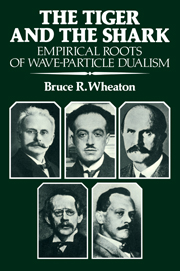Book contents
- Frontmatter
- Contents
- Foreword by Thomas S. Kuhn
- Preface
- Notes on sources
- 1 Introduction
- Part I The introduction of temporal discontinuity, 1896–1905
- Part II Ionization and the recognition of paradox, 1906–1910
- 4 Secondary rays: British attempts to retain mechanism
- 5 The appeal in Germany to the quantum theory
- Part III Seeking an electrodynamic solution, 1907–1912
- Part IV Interference of x-rays and the corroboration of paradox, 1912–1922
- Part V The conceptual origins of wave–particle dualism, 1921–1925
- Epilogue: The tiger and the shark
- Bibliography
- Index
5 - The appeal in Germany to the quantum theory
Published online by Cambridge University Press: 04 August 2010
- Frontmatter
- Contents
- Foreword by Thomas S. Kuhn
- Preface
- Notes on sources
- 1 Introduction
- Part I The introduction of temporal discontinuity, 1896–1905
- Part II Ionization and the recognition of paradox, 1906–1910
- 4 Secondary rays: British attempts to retain mechanism
- 5 The appeal in Germany to the quantum theory
- Part III Seeking an electrodynamic solution, 1907–1912
- Part IV Interference of x-rays and the corroboration of paradox, 1912–1922
- Part V The conceptual origins of wave–particle dualism, 1921–1925
- Epilogue: The tiger and the shark
- Bibliography
- Index
Summary
The unit of light energy does not travel in all directions away from an oscillator, but only in a single [direction.]
German-speaking physicists arrived at an explanation for the problems facing radiation theory different from that of their British colleagues. Moreover, their attempt to discover a consistent theory formed a complete contrast to the British attempt. The problems themselves were perceived differently. It would be an exaggeration to say that the problems ever reached the same status as paradoxes in Germany as they did in Britain. Physics as practiced in Germany was not as dependent on conceptual pictures, and physicists there were much more willing to adopt formal principles to solve the difficulties without demanding a consistent physical interpretation.
By 1905 the very word mechanics meant to many Germans something essentially different from its meaning in Britain. Influential voices had proclaimed that matter itself is only a construct of the mind, fashioned out of the more ontologically significant electromagnetic forces that give rise to human perceptions of mass and extension. The more influential Germans were not closely tied to the logical requirements of mechanistic thought. When the electromagnetic impulse hypothesis of x-rays was accepted in Germany, it was interpreted by many as a further example of the versatility of an electromechanical ontology. Electromagnetic impulses were considered by some, most notably those who first tried to make sense of x-ray behavior, as a form of wave with extended properties in space. Consequently, as we shall see in this chapter, the sharp distinction between x-rays and periodic light was never made as strongly in Germany as it was in Britain.
- Type
- Chapter
- Information
- The Tiger and the SharkEmpirical Roots of Wave-Particle Dualism, pp. 104 - 132Publisher: Cambridge University PressPrint publication year: 1983



